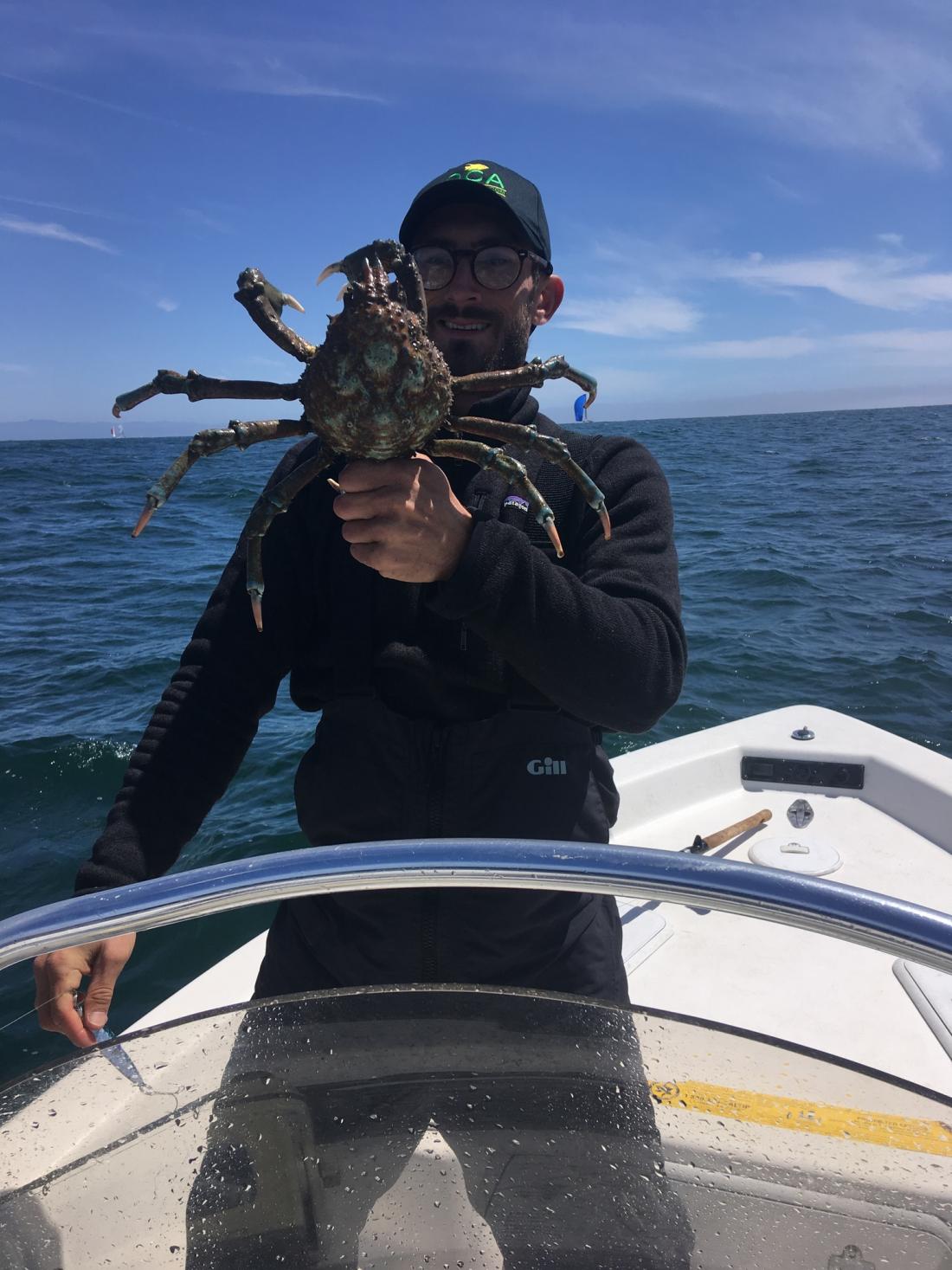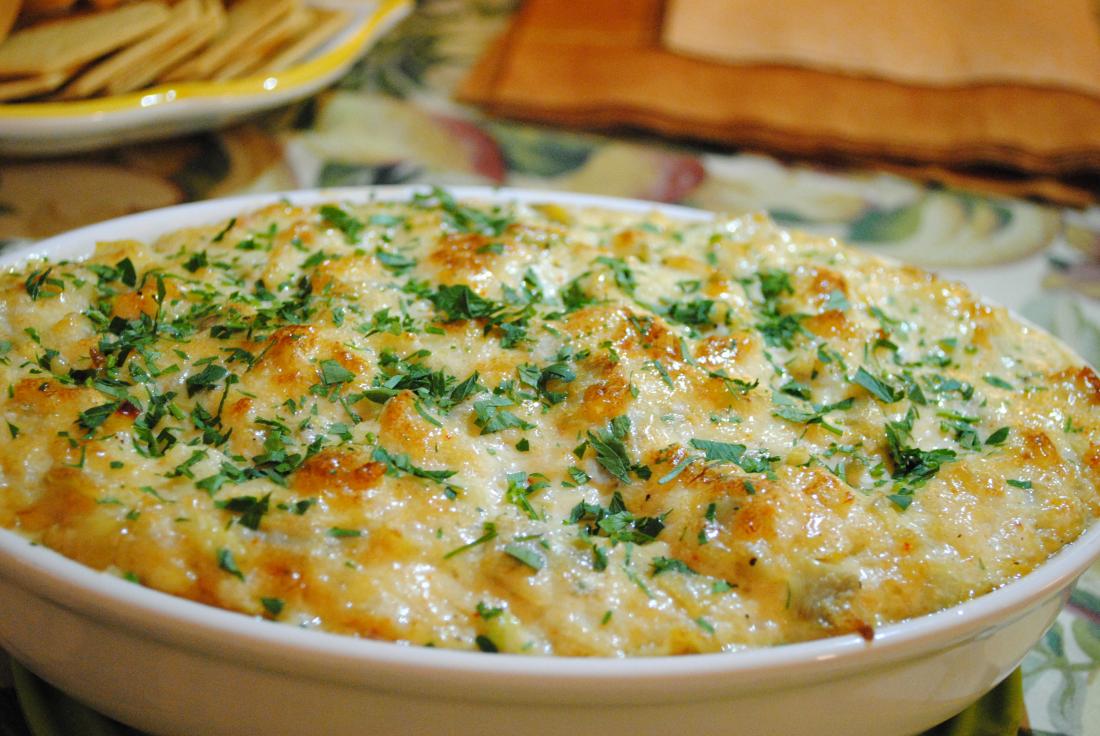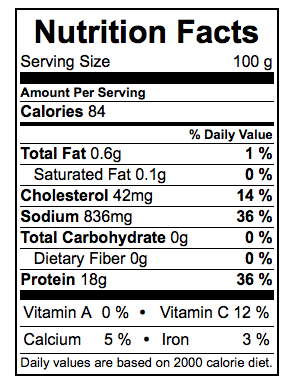Sheep Crab
Loxorhynchus grandis
The Science
THE SCIENCE
Masters of Disguise! The young mask their bodies with barnacles, bryozoans, hydroids, and algae. As they mature, adults develop a film of fuzzy green algae over their bodies.

Taxonomic description
- Has an oval-shaped body covered in spines and bumps. [1]
- Is the largest species in the family of California spider crabs (Majidae) with long, crawling legs and big, knobby joints. [1]
- Male adults have massive claws and legs longer than female adults. [1]
- Males’ bodies grow up to 17 cm (6.5 inches) and females’ bodies up to 11 cm (4.5 inches). [1]
Distribution
- Found from Point Reyes, California to Baja California, Mexico. [1]
Life history
- Life span is at least four years. [2]
- Maturity is defined by size— females mature with abdomen width of 10.7 – 17.3 cm (4.2 to 6.8 inches), males from 10.7 – 24.4 cm (4.2 to 9.6 inches) wide. [2]
- Egg-bearing females peak in late spring through summer and can store sperm for the future in the absence of males. [2]
- Male and females pile up on shore and hook back-to-back to mate. [2]
- Each brood ranges from 125,000 to 500,000 eggs. [2]
Habitat
- Males spend winter in deep water, and both sexes migrate toward shallower waters during warmer weather, dwelling in depths ranging 6 to 152 meters (20 – 500 ft). [1,2]
- Prefers to hide out in reefs and pilings. [1]
- Scavengers & carnivores: diet consists of live and dead bottom-dwelling organisms. [1]
- Small individuals of this species are preyed upon by cabezon, California sheephead, octopus, sharks, and rays. [2]
- Parasitic infections potentially impact young crabs, including the ribbon worm and rhizocephalan barnacle. [2]
The Fishery
THE FISHERY
Sheep crabs were of little commercial value until Santa Barbara fishermen experimented with marketing the claws in 1984.

Seasonal availability
- Available all year long. [2]
Regulatory and managing authority
- As established by the Marine Life Management Act, the California Fish and Game Commission (CFGC) regulates the fishery, and the California Department of Fish and Wildlife (CDFW) manages this fishery in state waters. [11]
- Under these management bodies, this fishery is managed through the California Spiny Lobster Fishery Management Plan as bycatch. [9]
Gear type
- During the spring and summer, crab and lobster traps are set in shallow, sandy-bottom areas about 9 to 21 meters (30 to 70 feet). [2]
- During the fall and winter, crab and lobster traps are moved to deeper waters about 37 to 73 meters (120 to 240 feet). [2]
- The common rock crab trap is made of wire mesh with entry funnel either on top or sides made of PVC pipe. [10]
Status of the fishery
- The market for sheep crab peaked in 1988 when 108,000 pounds of whole crabs and 96,000 pounds of claws were caught. [2]
- Landings declined in 1991 after the Marine Resources Protection Act (1990) phased out gill and trammel nets within 3 miles of mainland shore south of Point Arguello and near the Channel Islands, which heavily reduced catch of sheep crabs. [2]
- Fishing efforts for whole crabs are relatively low due to low profitability. [2]
- An experimental sheep crab fishery was recently established off Baja California, Mexico to increase crab landings. If successful, California commercial fisheries might adopt. [2]
Potential ecosystem impacts
- Overfishing of sheep crab (or other related crabs) can result in unregulated populations of bottom-dwelling scavengers and algae, but for now, this is not a concern. [9]
The Seafood
THE SEAFOOD
Sheep crab can be eaten steamed or grilled—makes for a luxurious camping meal!


Edible portions
- Meat in the claws and body are eaten. [3]
Description of meat
- Has a delicate flavor and firm texture. [3]
Culinary uses
- For a guide on how to clean and cook sheep crab, visit Spearboard or Tom Hunt. [4,5]
- For a South African crab curry recipe, visit EatMee Recipes. [12]
- For a Chilean crab dip recipe, visit Saveur. [13]
Nutritional information
- Low in saturated fat and good source of riboflavin, niacin, magnesium, phosphorous, and potassium. Excellent for protein, vitamin B12, zinc, copper, and selenium. [7]
- High in healthy levels of cholesterol and sodium, values listed in table. [7]
Toxicity report
- Domoic acid, a naturally occurring biotoxin in California crabs, can occasionally occur in the guts of crab during harmful algal blooms. Check for warnings before buying fresh, and be sure to clean out guts before preparing. [8]
Seasonal availability
- All year long. [2]
References
[1] Monterey Bay Aquarium. Sheep Crab. https://www.montereybayaquarium.org/animal-guide/invertebrates/sheep-crab . Accessed: 15 April 2017
[2] Culver, C. S., A. M. Kuris. 2003. Status of the Fisheries Report Through 2003. California Department of Fish and Wildlife, Marine Region (Region 7), Monterey, CA, USA. Web. https://wildlife.ca.gov/Conservation/Marine/Status#28027680-status-of-the-fisheries-report-through-2003. Accessed 11 Sept 2020.
[3] Jones, K. 2012. California Crabs. Ken Jones: Writer & Pierfisherman. http://kenjonesfishing.com/2012/01/california-crabs-%E2%80%94/. Accessed 18 April 2017
[4] Spearboard.com. 2015. Sheep Crab AKA California King Crab—cleaning and meat yield. http://www.spearboard.com/showthread.php?s=34fe226af7913fc3e8fcdf035f4f0f7e&t=180705. Accessed 18 April 2017
[5] Hunt, T. n.d. How to cook and prepare a spider crab. Tom Hunt. Web. https://tomsfeast.com/seasonal-recipes/how-to-cook-and-prepare-a-spider-crab/. Accessed 11 Sept 2020.
[6] from my point of view. shutterstock. n.d. delicious hot bisque or thick soup of shredded snow crab meat, prawn, lobster in a stainless metal casserole on black wooden table with kitchen towel, authentic french recipe, view from above. Digital image. Web. https://www.shutterstock.com/image-photo/delicious-hot-bisque-thick-sou…. Accessed 23 December 2020.
[7] SelfNutritionData. Crustaceans, crab, Dungeness, Nutrition Facts & Calories. http://nutritiondata.self.com/facts/finfish-and-shellfish-products/4248/2. Accessed 1 May 2017.
[8] Culver, C., C. Pomeroy, and J. Tyburczy. 2016. California Sea Grant. Frequently Asked Questions: Domoic Acid in California Crabs. https://caseagrant.ucsd.edu/project/frequently-asked-questions-domoic-acid-in-california-crabs. Accessed 1 May 2017.
[9] California Department of Fish and Wildlife. 2016. California Spiny Lobster Fishery Management Plan. California Department of Fish and Wildlife. https://www.wildlife.ca.gov/Conservation/Marine/Lobster-FMP. Accessed 1 May 2017.
[10] NOAA. 2017. CA Rock Crab Pot Fishery. http://www.nmfs.noaa.gov/pr/interactions/fisheries/table1/wcr/ca_rock_crab.html. Accessed: 30 May 2017.
[11] Marine Life Management Act. n.d. California Department of Fish and Wildlife. Web. https://wildlife.ca.gov/Conservation/Marine/MLMA. Accessed 24 August 2020.
[12] EatMee Recipes. 2020. South African Crab Curry. Web. https://eatmeerecipes.co.za/indian-cuisine/south-african-crab-curry/. Accessed 3 February 2021.
[13] Saveur. 2016. The Ultimate Crab Dip. Web. https://www.saveur.com/crab-dip-recipe/. Accessed 3 February 2021.
[14] Bear, M. iNaturalist. 2015. Digital image. Web. https://www.inaturalist.org/photos/6900579. Accessed 24 February 2021.
[15] Stiefel, K. flickr. 2006. Sheep Crab. Digital image. Web. https://www.flickr.com/photos/41059842@N03/3876670216. Accessed 24 February 2021.
[16] joe_cutler. iNaturalist. 2019. Digital image. Web. https://www.inaturalist.org/photos/34770314. Accessed 24 February 2021.
[17] citymama. flickr. 2010. Crab-artichoke dip. Digital image. Web. https://flickr.com/photos/citymama/5207774373. Accessed 24 February 2021.



